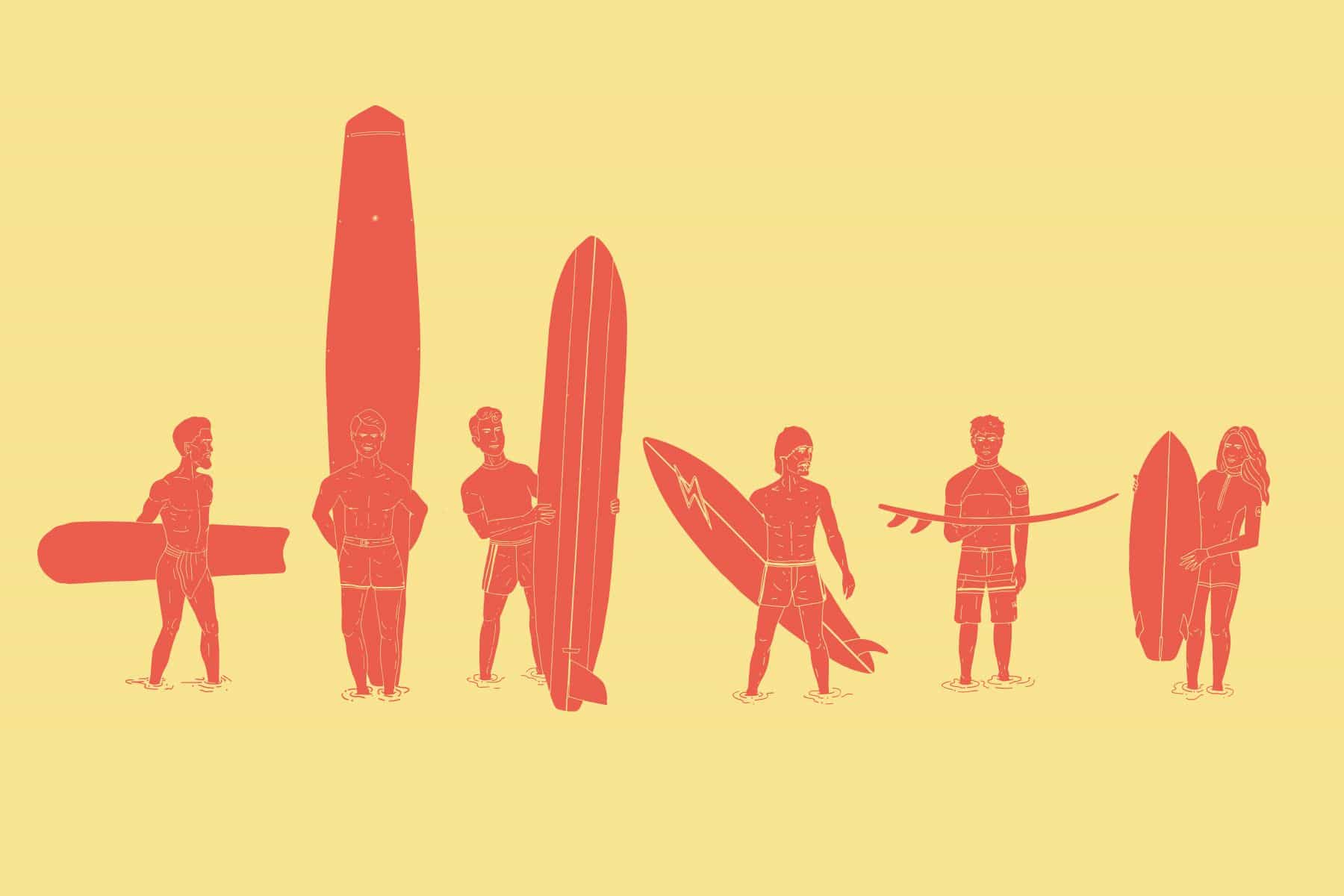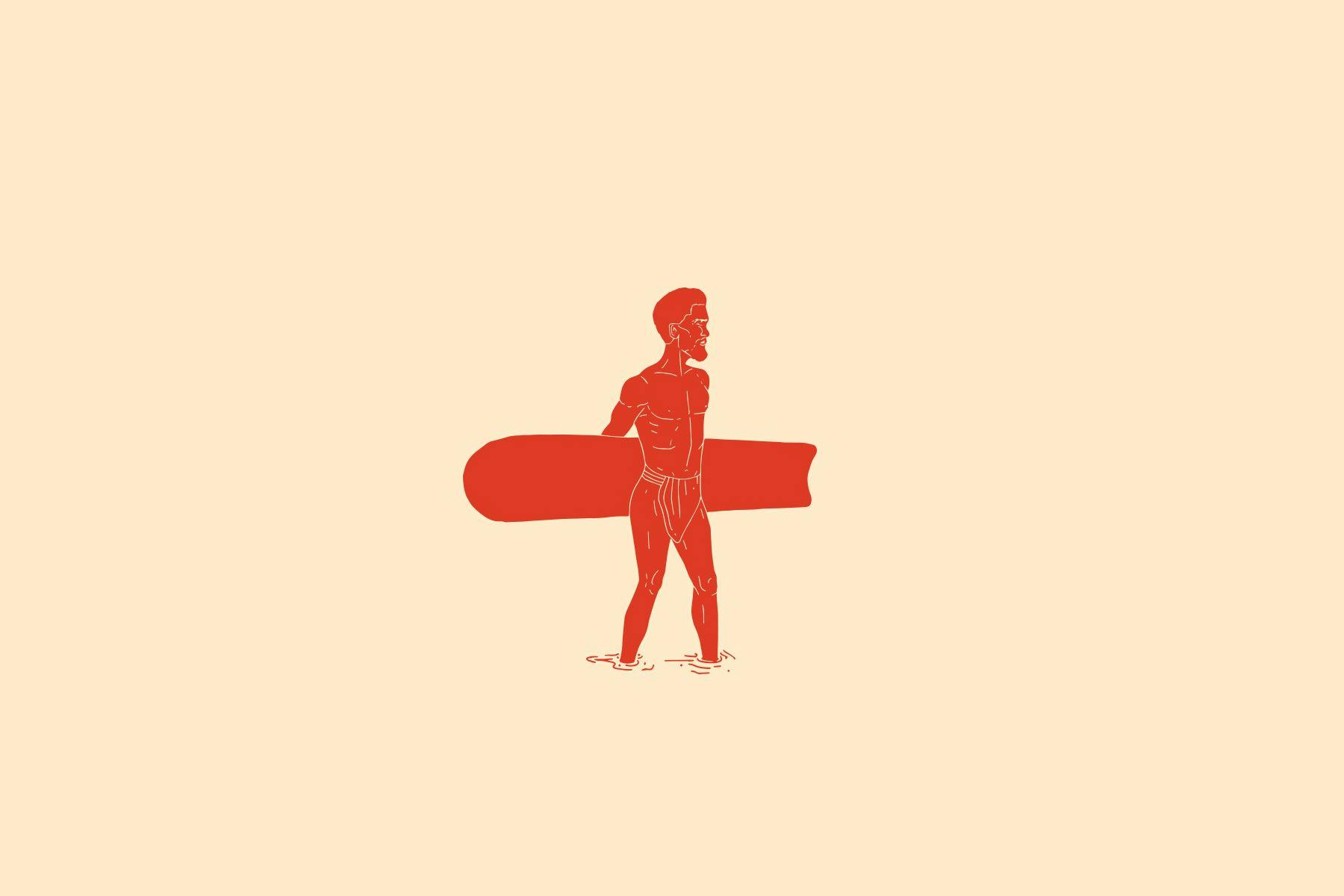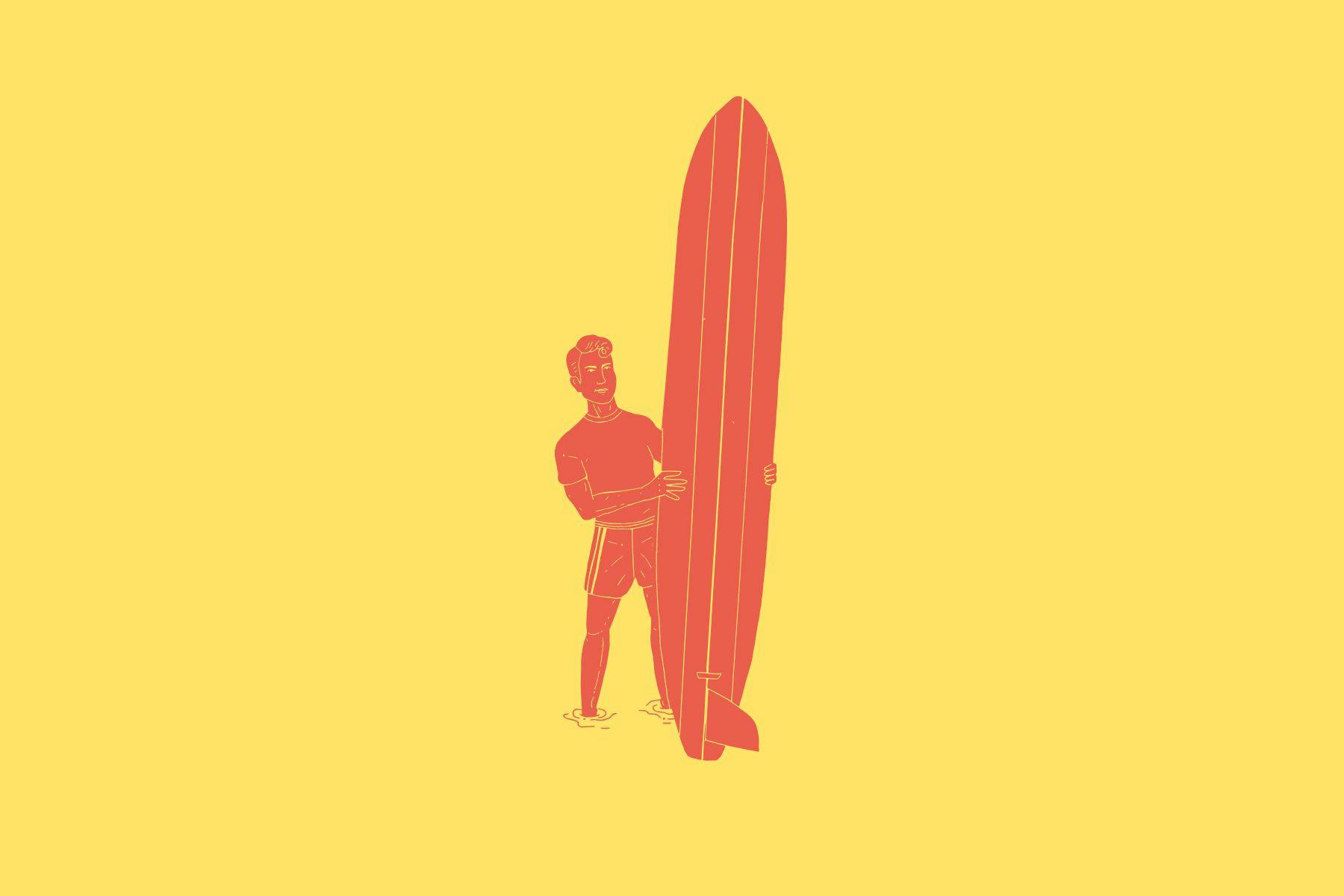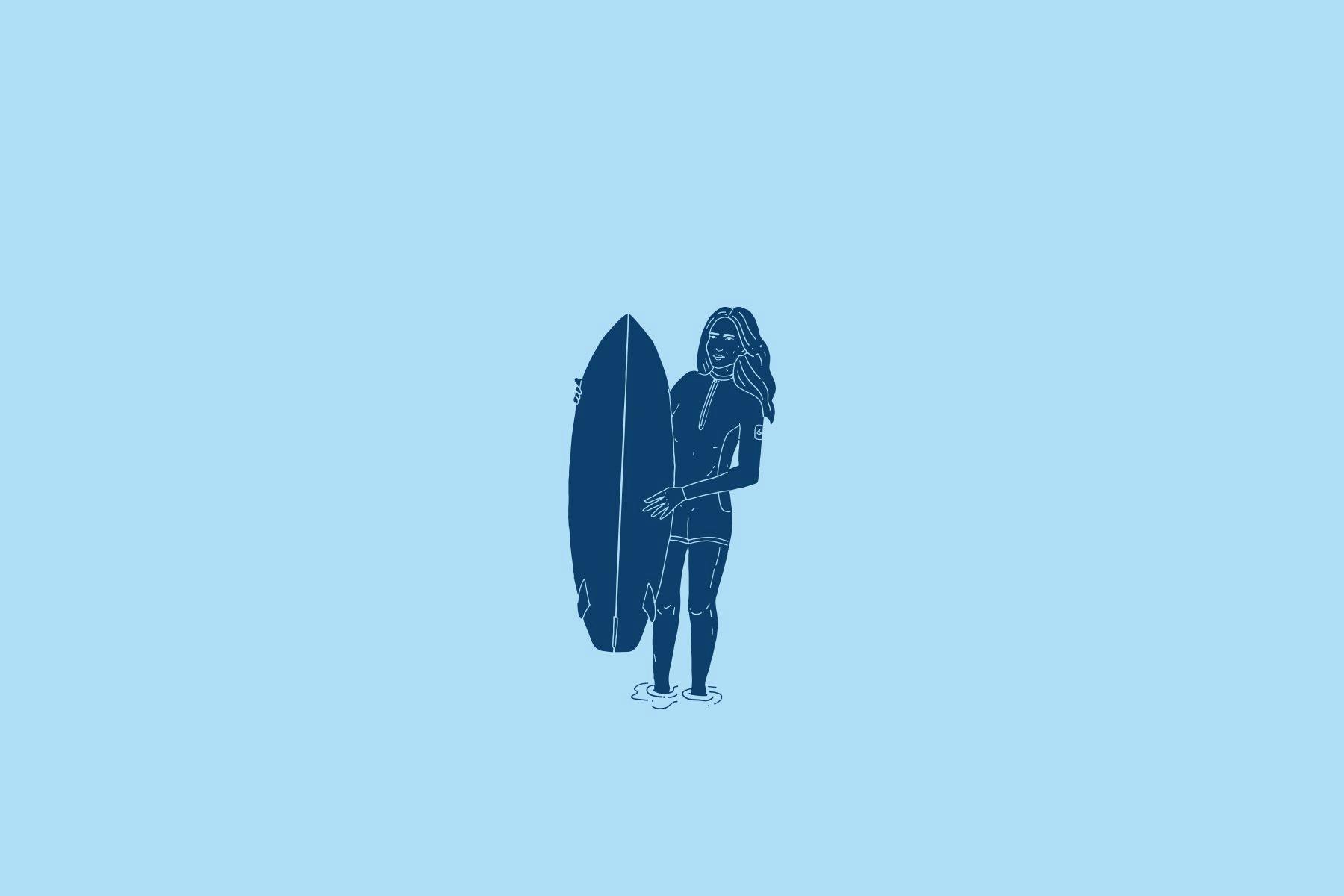Surf culture, SurfboardsThe History of Surfboard Design

Objects evolve; sometimes slowly, surely, and almost imperceptibly, and at other times through explosive design revolutions. But they always evolve in a never ending process of refinement and improvement. The surfboard is no exception.
From a basic means of transportation made of bound reeds through to today’s ultralight high-flying foam composites, ‘The Surfboard’ provides a perfect example of the design developments and mutations that can occur when, over a long period of time, many people come together around a common purpose. Here, we present a chronology of the key moments in the history of surfboard design, as the foundation article for a series examining key designs and developments in the wave riding tool that makes this whole undertaking possible.
Ancient Origins
- The earliest recognisable evidence of wave-riding craft is from archaeological sites in Peru that date back as far as 3000 years BC. Ancient South American civilizations made long, high-prowed crafts by binding together local totora reed (Californian Bullrush) that fishermen could paddle out to sea through the surf and then ride waves back to shore on their return.
- Ranging between 3-5 metres (9 to 15ft) in length, a metre (3ft) wide and weighing 40kg (90lbs), the dried reeds were bundled together and bound to make a shaped raft that wouldn’t be swamped by the white-water. Records describe the local fishermen riding the craft either by laying face down and paddling with their hands, or kneeling and using a horizontally-cut bamboo stick as a paddle.
- By the time the Spanish arrived almost 4500 years later, the art of riding waves with these crafts had developed and they were formally named Caballitos de Totora (little reed horses).

First Contact
- Around 300AD, Polynesians migrated east across the Pacific Ocean and settled the Hawaiian Islands, bringing with them their culture of he’e nalu.
- Surfboards from this period fall into one of three categories: the enormous regal Olo, the Alaia, and the commoners Paipo, all made from Ula, Koa, WilliWilli and sometimes even breadfruit trees.
- These flat, solid planks of wood were part of the code of kapu (taboos) that structured early Hawaiian society and were used in rituals, recreational activities, training for Hawaiian chiefs and as a means of conflict resolution.
- The Paipo, the smallest of these, was a round-nosed, flat belly-board, ridden prone by commoners and children, varying in length between 1 to 2 meters (3 to 6ft) with an average width of 40cm (16 inches) and a little over 1cm (1/2 inch) thick.
- The Alaia was the most versatile and widely used surfboard and they were thought to have been ridden sideways across the unbroken face of the wave. The 7-12 foot long by 18 inch wide design features a round nose and a square tail. When Captain Cook arrived in Hawaii in July 1778 he was the first westerner to witness a person paddling a surfboard; that surfboard was an Alaia.
- In contrast, the Olo were exclusive to royalty and measured between 3 to 6 meters (10 to 20ft) in length by almost 1 meter (3ft) wide and weighed up to 90kg (200 pounds). They were used to catch and ride unbroken waves in a straight line to shore.
1900-1920s
- Surfing’s revival occurred in the 20th century as the U.S. annexed Hawaii, and American settlers arrived in the islands with a curiosity for local culture that allowed surfing to experience a resurgence in popularity.
- Surfboard design in the first two decades of the 20th century was characterised by the deviation from local hardwoods and an experimentation with the different types of wood (especially redwood), that were being shipped to Hawaii from the mainland (primarily for use in construction).
- George Freeth, who is largely credited as spreading surfing to the U.S. mainland, cut his 16ft Alaia in half and experimented with redwood which led to the development of the ‘plank surfboard’ (a lighter, shorter and more manoeuvrable surfboard that was still straight and flat).
- In 1910, Duke Kahanamoku customizes his version of a “plank board” made of redwood, with a blunt nose and square tail, measuring 10 feet in length, 23 inches in width, 3 inches in thickness and weighing 70 pounds; a design that would be serve as a prototype for the widely available Swastika/Waikiki model (made out of pine wood), a couple of decades later.

1930s
- Tom Blake revolutionises surfing in 1929 when he creates the first hollow surfboard (later nicknamed “cigar boxes”) by drilling holes in a 15’x19” solid wood paddle board to reduce weight and covering the top and bottom with a thin skin of plywood. He developed his idea into a “skin-on-frame” design and patented it in 1931. It became the first mass-produced surfboard design, with a number of companies producing variations of the Blake design.
- At the same time, Meyers Butte, son of the founding partner of Pacific System Ready Cut Homes (a huge home building company) launched a line of Swastika branded solid wooden plank surfboards (early models were solid redwood, but by 1932 they were pine with redwood edges, and later balsa and redwood).
- In 1934, inspired by necessity – or rather the fact their boards weren’t “biting” the wave and slid out far too easily – John Kelly and Fran Heath took the next big step in surfboard design evolution when they shaved off parts of the rail and tail of one of their plank surfboards in an attempt to get more control and make their surfboards more responsive through turns. This adaptation was called the hot curl because it allowed the surfers to manoeuvre into the “curl” of the wave.
- In 1935 Blake adds a small 1’ long, 4” deep skeg from a small speedboat to the tail of his surfboard and is widely credited with inventing the fin.
- In 1937 the rise of the Nazis caused Pacific System Homes to rename the “Swastika” range “Waikiki”.
1940s
- Advances in materials technology driven by WWII, such as the development and refinement of plastics, plastic foam (such as polyurethane foam) and fibreglass, begin to fuel experimentation in surfboard design and construction.
- In 1946 Santa Monica lifeguard and surfboard shaper Pete Peterson (the father of lifeguarding’s Peterson tube) made the first hollow moulded plastic surfboard, with a redwood stringer and sealed with fibreglass tape.
- In 1947 Joe Quigg created the ‘Darrylin’ board – a balsa and redwood shape (named after its owner) that weighed a surprising 25 pounds and later became the prototype for the ‘Malibu Chip’.
- Also in 1947, Quigg and Bob Simmons teamed up to build the first polyurethane foam-core “sandwich” boards – which were sheathed with a thin layer of plywood, had solid balsa rails and were covered with fibreglass. They also experimented with all-fibreglass fins, both ideas that would later be developed more in-depth.
- In 1948, Quigg makes a series of experiments where he sliced his board in half lengthwise, cut a 1 inch strip from each and attached them back together (reducing the deck to 21 inches of width), and glassed a fin right at the tail. His aim was to improve the hold of his surfboard to allow him to surf the fast lines of Rincon, and his development became known as the ‘pintail’ surfboard’.
- By 1949, Simmons’s experiments led to his ‘Spoon’ model: a 24-inch wide, board with a thin squared-off tail and spoon-like nose design. Simmons opted for balsa-only construction and continued to pioneer the use of resin-saturated fibreglass to cover surfboards. His models weighed around 25 pounds and were faster and more controllable than most surfboards of the time.
- Simmons was also one of the first to experiment with ‘double-finned’ boards and he is credited with the invention of rocker and the appliance of the fundamental hydrodynamic principles of foil and rail profiles, transforming the surfboard from a flat plank into a smooth curve.
- At the end of the decade, Joe Quigg and Matt Kivlin applied some of Simmons’s design features into their own shapes and refined the Malibu Chip design. The “Chip” was a balsa-core surfboard with a stabilizing fin right at the tail that allowed easier and tighter turns and was later used as inspiration for the development of the modern longboard.

1950s
- In 1950, George Downing produces the first big-wave surfboard. ‘Rocket’ was a 10 foot surfboard; narrow, streamlined and with a pointed tail inspired by the ‘Hot Curl design’, but constructed from balsa, fibreglass and resin, it allowed Downing, Wally Froiseth, Woody Brown and others to push the limits of big wave surfing.
- In 1951, Downing introduces the removable fin system to his rocket design, but the idea would only be popularized in the following decade.
- Surfboard makers start to experiment more widely with new plastic foams such as polystyrene and polyurethane (developed during WWII) during the 1950s as a light and easy to shape alternative core material to Balsa.
- From the early to mid-’50’s, Tom Blake developed a prototype of the ‘double-pinned swallowtail’ by reshaping a Bob Simmons board that had made its way to Hawaii.
- Also in the mid-’50s, Simmons introduces the idea of a longitudinal concave, hoping to increase the speed of the surfboard by “lifting” it off the water and reducing friction.
- In 1955, Dale Velzy creates the revolutionary ‘Pig model’. The design – constructed of balsa – was around 10ft long, weighed 25-30 pounds and featured a wide and blunt tail with relatively narrow nose. This allowed for better manoeuvrability and fitted into different sections of the wave.
- Also in 1955, Hobie Surfboards laminator Gordon “Grubby” Clark began to develop polyurethane foam molds as part of the company’s search for an alternative to balsa. In 1958 Hobie Surfboards (which was one of the largest surfboard manufacturers in the world) began to exclusively produce polyurethane foam surfboards.
- Later in 1958, the stringer starts to appear in surfboards as a means of strengthening the polyurethane foam blanks.
- Towards the turn of the decade, Pat Curren refined the design of big-wave surfboards by crafting 11-foot-long balsa guns that weighed around 40 pounds and gained recognition for their fine quality, contributing to his accomplishments as a big-wave rider.
1960s
- In 1961, Gordon Clark left Hobie and founded Clark Foam – a company that would become the world’s leading producer of polyurethane foam blanks.
- Throughout the 60s various companies marketed molded plastic “pop-out” surfboards, particularly focusing on the booming beginner market. They were met with derision by the rest of the surf industry and media, but are still being produced by several companies.
- In 1966 Australian Bob McTavish and Californian George Greenough work together on designs that would bring features from knee-boards into regular stand-up surfboards in order to ride more easily in and around the curl.
- In early 1966, McTavish and Nat Young designed and shaped ‘Magic Sam’ – a thinner and lighter interpretation of a longboard which Young won the 1966 World Championships on.
- 1967 is known as the year of “The Shortboard Revolution”, which has two competing sources in both the Greenough influenced designs of McTavish, and Hawaii-based shaper Dick Brewer.
- In 1967, McTavish created the ‘Plastic Machine model’, a nine-footer with a deep vee-shaped keel through the back of the board and a wide tail. He developed the design throughout the year, aiming for smaller and lighter characteristics and went from the usual 10’ by 25 pounds to a 7’6” and 14 pounds board.
- Brewer claimed to have started shaping shorter surfboards for Hawaiian surf in the spring of 1967.
- Dick Brewer develops the “mini–gun’ in 1967 by cutting a 9’6” down to an 8’6. The design featured a drawn out tail, flat bottom with slight vee at the tail and hard “down” rails that increased speed and hold.
- Also in 1967, inspired by Bob Simmons’s twin-fin designs, brothers Nick and Bear Mirandon (of La Jolla Surfboards) marketed their split-tailed, two-finned model called ‘Twin-Pin’, which although didn’t do well commercially, led to the development of knee-boarder Steve Lis’ ‘Fish design’ – a blunt-nosed and stumpy shape, with two fins, low-rocker and a split tail.
- In the same year, surf-designer Tom Morey popularizes the idea of the removable fin system, with the introduction of the A.V.E. set (Water Apparatus and Vehicular Engineering Interchangeable Fin System), consisting of six different polypropylene fins ready to be bolted into a “fin-box” in the bottom surface of a surfboard’s tail.
- Around the mid-’60’s the all-fibreglass fin – and later the hard plastic fin – replaced the “wood-and-fibreglass” designs. The standard template of a fin also developed into something more like the dorsal fin of a dolphin (due in large part to the influence of George Greenough), thus assisting sharper turns.
- In the late 60’s, following the creation of the vee-bottom, the round-tail was introduced and popularized as one of the biggest steps in the short-board revolution, earning its fame for being the era’s easiest-turning tail design.

1970s
- In 1970, Gerry Lopez and Jack Shipley founded Lightning Bolt. They fine-tuned the popular design of the moment – the ‘rounded-pin single-fin’ – and added a coloured lightning bolt on the deck of all their shapes, causing a worldwide sensation.
- In 1972, Californian brothers Malcom and Duncan Campbell designed the ‘Bonzer’ – a three-fin model, where two keel-like side fins sit slightly ahead of the centre fin and two concaves run down the middle and tail sections. The design was claimed to be faster and more manoeuvrable than the standard single-fin boards.
- In the late 1970s, Brewer further developed his down rail profiles into the even harder “tucked under” edge.
- In 1977 Australian Mark Richards – with the help of Dick Brewer – redesigned and developed a 6’2” version of the twin-fin model, which became widely popular as “the ultimate small-wave board”.
- Throughout the mid and late ‘70s, the swallowtail joined the round-pin, square and diamond-tail – as one of the standard tail designs.
- Also in the late ‘70s Geoff McCoy and his test pilot Cheyne Horan experiment with moving the wide point extremely far back creating a shape with a wide, bulbous tail and a drawn out and pointed nose, often called the “Needle Nose”. Like its tail-centric precursor “The Pig”, McCoy’s Needle Nose was designed for increased speed and tighter turns.
- French board-maker and engineer Michel Barland invents the first computerized shaping-machine in 1979, making it possible to cover higher demands and standardize (if not improve) the quality of shapes.
1980s
- Al Merrick (shaping under his Channel Islands Surfboards label) popularizes the ‘tri-plane hull’ (first introduced by Hobie Surfboards in 68, then re-worked by shapers Jeff Ho and Mickey Fremont in the late ‘70s), where two longitudinal concaves are flanked on both sides by flat surfaces that run out to the rails, causing less loss of speed than a usual flat-bottomed board.
- Simon Anderson takes the concept of a three-fin setup and applies it, creating the ‘thruster’ model in 1981. This new system united the best features from the single and twin-fin setup, providing greater control and faster response to surfers’ more aggressive styles. Around the world surfers started converting to the three-fin setup and it soon became the most popular model of surfboard on the market.
- Soon after the boom of the thruster, Australian Glen Winton popularizes the ‘quad-fin’ in 1982, which was in essence a re-design of the twin-fin.
- In 1982, New Zealand shaper Allan Byrne adapts the concept of a ‘channel bottom board’ (first thought of by Australian Jim Pollard in 1974) into the tri-fin design. The design features elliptical channels in the rear half of the board with the intention of increasing speed by flushing water towards the tail.
- Also in the early ‘80s, the squash-tail (a square-tail with rounded corners) becomes popular and is chosen by most as a favourite for the newly introduced ‘thruster’ surfboard.
- After the popularization of the thruster, design changes through the rest of the ‘80s focused on refining the still boxy-railed shortboards to create thinner, lighter and narrower boards. An apparent “moment of calm” in design evolution gave space to attention to detail, that together with the popularization of the sport allowed an increase in retail prices.

1990s
- In the early ‘90s, Australian shaper Maurice Cole introduces the ‘reverse vee’ (a revision of the vee bottom concept, only with the vee in the middle of the board flowing into two parallel concaves or a flat bottom towards the tail) in the attempt to increase the board’s speed.
- In 1992, the Momentum Generation of high performance shortboard surfing is represented in surfboard evolution through Al Merrick’s narrow, thin, and highly rockered shortboards for Kelly Slater – reducing width to under 18 inches –, as well as Shane Herring and Greg Webber’s experimentations with greater rocker and deeper concaves.
- Also in 1992, Hawaiians Laird Hamilton, Buzzy Kerbox and Darrick Doerner were inspired by the concept of power-assisted surfing – that dated back to 1963 – and began to apply it to 15-foot-plus waves on the North Shore of Oahu by towing each other into waves, first using an inflatable Zodiac boat and later using jet-skis.
- In 1993, Laird Hamilton begins to work on the design of tow-in surfboards, mainly focusing on reducing their size and increasing weight.
- In 1994, the development of CAD/CAM (Computer Aided Design and Computer Aided Manufacturing) software allows the creation of computer-designed surfboard shapes, making manufacturing more streamlined and precise, automating much of the process of shaping a surfboard out of foam materials to exact specifications.
- In the mid-’90s, FCS improve the old “slot and screw” system (pioneered by Tom Morey in 1968) into a “circular plug and tab” structure, allowing surfers to experiment with fins of different sizes, shapes and materials.
- Steve Lis’ original ‘fish’ design experiences renewed interest, when a shorter, wider and thicker than average three-fin surfboard, labelled as a fish and inspired by the original design, appeared on a 1997 …Lost Surfboard’s video, 5’5” x 19 ¼”.
- Another mid-’90s development (cited by many as one of the decade’s most important) was the reinvention of the concave bottom configuration as the ‘single-to-double’, which consisted of a shallow and wide concave in the middle of the board flowing into two concaves through the tail, increasing the board’s speed and turning capability.
- In 1997, the idea of a ‘molded surfboard’ was popularised by California-based company The company developed a large range of models with a foam core wrapped in a layer of high-density sheet foam, epoxy resin and fibreglass, topped with polyurethane paint, resulting in a lighter and stronger board but retailing at a higher price and frequently labelled by purists as “soul-less”.
- The ‘90s saw the resurgence of longboard surfing, a movement that since it’s slump in the 1970’s had gradually been regaining popularity (this time on lighter surfboards and often with a three-fin setup). In the years that followed longboards began to represent a big chunk of surfboards sales – according to Clark Foam’s annual sales figures, over 50% of foam blanks sold were over 8’ long.
2000s – Present Day
- In the beginning of the 21st century, Carl Ekstrom (proponent and developer of the ‘asymmetrical’ surfboard concept in 1965) teamed up with Richard Kenvin, Ryan Burch and Hydroflex to produce surfboards based on his assymetrical theories.
- In 2004, shaper Tom Wegener started producing Alaias from paulownia wood in Australia. Professional surfers including Dave Rastovich, Rob Machado, Dan Malloy and Chris Del Moro’s explorations into the realm of finless wave-sliding (coupled with the fact that Alaias could be self-shaped relatively inexpensively by curious surfers) helped to popularise the concept of revisiting the Alaia design.
- Volume began to become a key surfboard dimension in the noughties, in part facilitated by the growth in CAD/CAM machine shaping allowing the volume of a surfboard to be easily calculated. Everyday surfers began to order more “user friendly” higher volume surfboards, and there was a distinct shift towards “short, fat, wide” shapes in the “everyday shortboard” market.
- In 2005, the world’s biggest polyurethane foam producer, Clark Foam, shut its doors suddenly and somewhat mysteriously, directly impacting board makers (causing a spike in the price of surfboards as world blank availability contracted), and prompting a “revolution” in alternative materials.
- At this time it was estimated that around 8% of surfboards produced were laminated with epoxy resin systems – although epoxy, which allowed the use of alternate foam cores such as expanded polystyrene (EPS), had been used by several shapers since the early 1980s. Lighter and more durable than their PU/polyester counterparts and less toxic, epoxy/EPS surfboards initially commanded a higher price tag but have been growing in popularity and it is now the go-to technology for large surfboard manufacturers such as Surftech and Firewire.
- As of 2006, there have been major developments in the use of “environmental friendly” materials in surfboards (such as the creation of Biofoam and Bioresins, which replace some ingredients of the foam or resin with materials derived from soy, sugar or algae for example) from the core blank material to the resin and cloths used. There has also been a growing acceptance of materials such as wood and cork and corresponding construction techniques.
- In 2006, the alternative surfboard line Firewire was launched by Australians Hyman and Burger. It quickly gained a foothold in the market with its innovative use of materials (based on layers of foam laminated with epoxy, parabolic balsa rails and optional wood-veneer deck panels) and due to the legitimacy given to the technology through the endorsement and performance of professional surfers such as Taj Burrow.
- Also in 2006, Parker Borneman and Edison Conner founded Varial Surf Technology, a company focused on using advanced composite technology to bring surfboard performance to the next level through the development of stronger and lighter aerospace-grade cores.
- Through the mid-00s several high profile surfers and surfboard shapers experimented with shorter, wider and thicker surfboard designs. Most notably, Kelly Slater and Dane Reynolds both competed on such designs in WCT events around this time, with Matt Biolos’ …Lost Surfboards label adding several new “short/fat/wide” models to their range.
- In 2007 renowned Swedish-American product designer Thomas Meyerhoffer launched a range of attention-grabbing hourglass-shaped longboards, which were produced and marketed by Global Surf Industries.
- By 2009, Richard Kenvin’s Hydrodynamica project had revived Bob Simmons’ 1940’s hydrodynamic planing hull theories, reapplying the concept to modern designs and inspiring surfer/shapers such as Ryan Burch, Tyler Warren and Daniel Thomson. Birch in particular rose to prominence when he began to ride a simple slab of un-glassed closed cell foam.
- In 2012 Firewire, now a global player based in California, partnered with innovative Australian shaper Daniel Thomson, adding his “TOMO” branded designs to their range as a sub-label and producing a line of unconventional boards such as ‘The Vader’ and ‘The Evo’ that featured Thomson’s interpretations of planing hull theory, rectangular noses, forked tails and wide, deep concaves.
- In 2014 Australian shaper Hayden Cox wins the first of three “Surfboard of the Year” awards for his Hypto Krypto surfboard, an all-round shortboard for small to medium-size waves that has become one of the best-selling surfboards ever.

Surfers and surfboards through the ages illustrated by Clara Jonas.